
Organisation of the Organism (1.6-1.7)
Cell structure and organisation
All living organisms are made of cells
Cell: The basic structural unit of life
Although cells carry out different functions, animal and plant cells both have common features:
Cell membrane
Cytoplasm
Nucleus
Endoplasmic reticulum
Mitochondria
Ribosomes
Golgi Body
Lysosomes
Plant cell | Animal cell |
|---|---|
Has a cell wall | No Cell wall |
Chloroplasts is present | No chloroplasts |
Vacoules occupy most space | No vacoule |
Starch as carbohydrate store | Glycogen as carbohydrate store |
Autotrophic | Hetrotrophic |
No secretory vesicles | Secretory vesicles present |
Regular shape | Irregular shape |
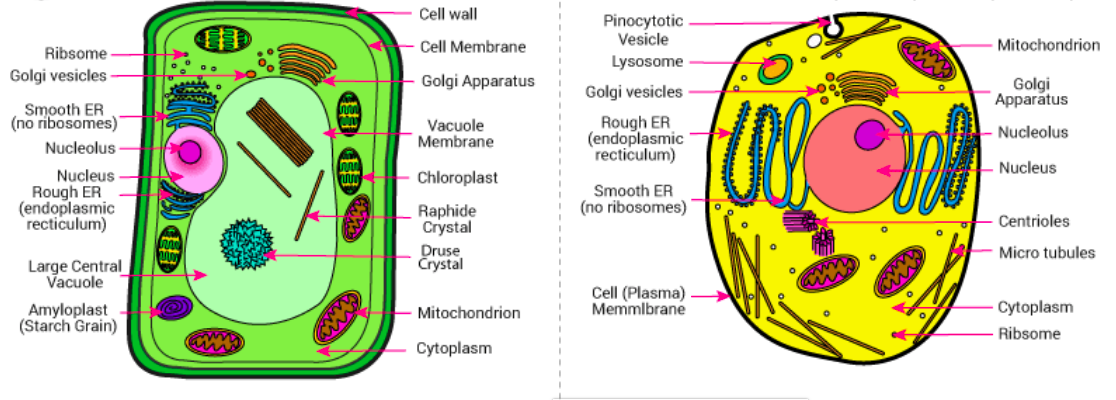
Functions of Cellular structures
Cell wall: Outer most sstructure in the plant cell, made of cellulose and is dead
→ Fully permeable; allows substances in and out of the cell
→Gives the cell its shape and structure
Cell membrane: Located inner to the cell wall in a plant cell and the outermost structure in an animal cell
→Semi-permeable; allows some/specific substances in and out of the cell
Cytoplasm: Jelly like fluid inside the cell made of water and dissolved substances eg. glucose & salt
→Site of all metabolic (chemical) reactions
Nucleus: Contains genertic material of the cell in chromosomes which controls cell functions
→Controlling centre of the cell
→Determines quality and quantity of proteins made by the cell
Chloroplasts: Site of photosynthesis
→Contains a green pigment (chlorophyl)
→Chlorophyl absorbs light energy and converts it into chemical energy by photosynthesis
6H2O + 6CO2 → C6H12O6 + O6
Mitochondria: Made up of a doublr membrane: inner and outer
→ Inner has many foldings to increase the surface area for enzyme reactions
→Site of aerobic respiration and release energy
→ ‘Powerhouse’ of the cell
Rough of Endoplasmic Reteculum: Membranous outgrowth of outer nuclear membranes and has ribosomes attached to its surface
→Site of synthesis and transport of protein
Ribosome: The smallest cell of organelles present in the cytopplasm
→Either free or attached to rough ER
→Site of protein synthesis
Vacoule: Large, permanent, cenraly located in a plant cell but small and temporary in animal cells. Contain cell sap which is a solution of nutrients and salts
→ Provides turgor pressure to the plant cell and helps maintain its shape
Vesicle: Sac like structures containing secretory substances eg. enzymes in the cytoplasm
Specialised Cells
Large organisms are multicellular
Different types of cells have particular structures to help them carry out specific functions, and so they become specialised
Specialised Cells in Plants
Root hair cells:
Absorb nutrients from soil by osmosis
Absorb minerals by active uptake/transport
Fix the plant in the soil
→Adaptations:
Have finger like outgrowth to increase the surface area for more absorption
Have extended vacoule and cytoplasm for easier absorption
Have more mitochondria to privude energy for active uptake/transport
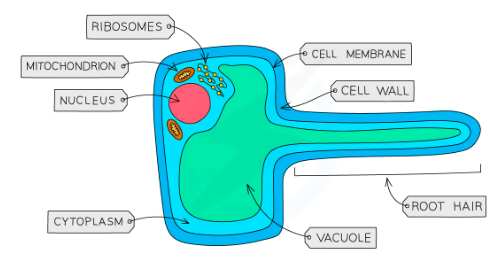
Xylem vessels:
Found in vascular bundles
Transport water and minerals from the roots to the stem and leaves
Provide mechanical support to the stem and leaves
→Adaptations
Do not have a nucleus or cytoplasm to make space for bulk transport of water and minerals
Cells are dead and hollow and connected from end to end to form a long continous tube
Cell wall is strengthened with lignin (hard substance) which gives mechanical support
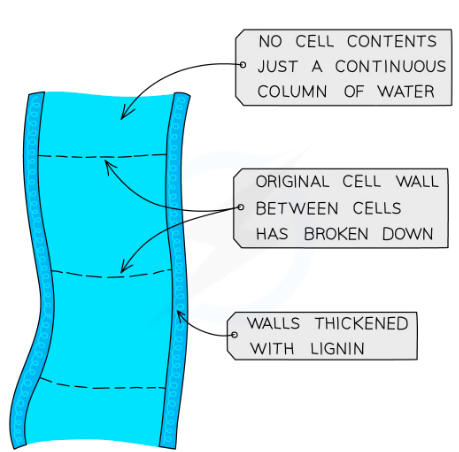
Specialised Animal Cells
Red Blood cells:
Transport oxygen from lungs to the rest of the body
Transport CO2 from the body to the lungs
→Adaptation
Red pigment (haemoglobin) which binds with oxygen to allow transport
Dont have a nucleus; increase the surface area to carry more oxygen; biconcave shape
Spongy/ flexible to squeeze into cappilaries
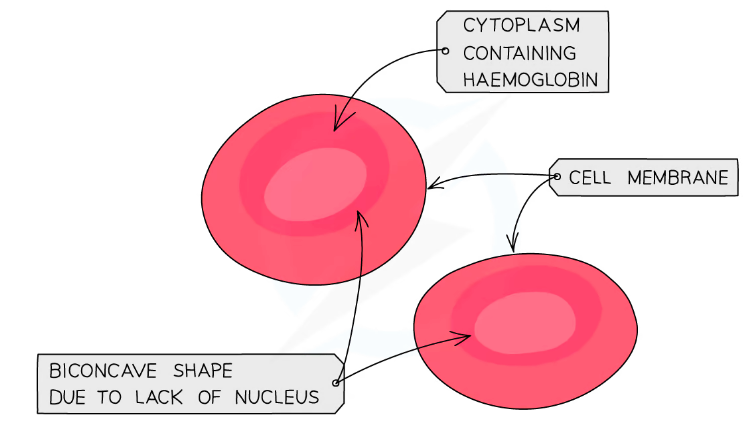
Ciliated Epithelial cells:
Goblet cells secrete mucus which traps the dust particles from the inhaled air
Cillia of the cells beat and push the trapped dust and air towards the throat (outside)

Muscle cell:
Contracts and relaxes and brings about movement
Contracts and relaxes so that structures can be brought closer
→Adaptation
Made of myofibres which have the ability to contract and relax
Have protein fibre; can shorten the cell when energy is present
Nerve cells:
Sensory nerve cell: Conducts message from sense organ to the central nervous system
Motor nerve cell: Carries message from central nervous system to the effector
→Adaptation
Has extensions and branches so that it communicates with other nerve cells and glands
The Axon (extension of the cytoplasm away from cell body to carry impulse long distances) is covered with fatty sheath which insulates the cell and speeds up the nerve impulse
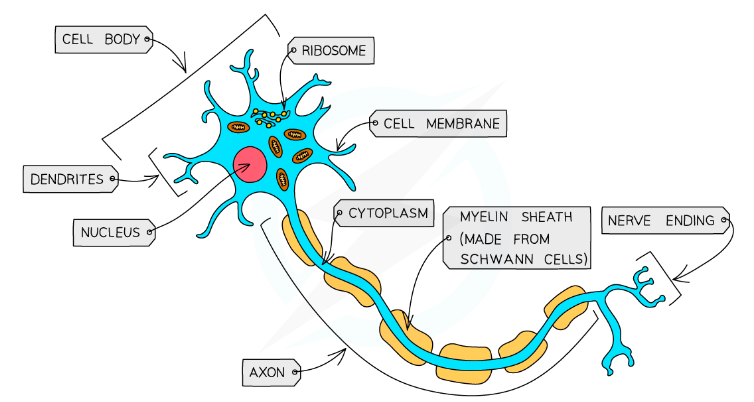
Egg cell:
Female gamete (responsible for reproduction in females)
→Adaptations
Alot of cytoplasm that contains alot of nutrients for the growth of the early embryo
Haploid nucleus containing genetic material for fertilisation
Cell membrane that modifies after fertilisation so that only one sperm cell can penetrate
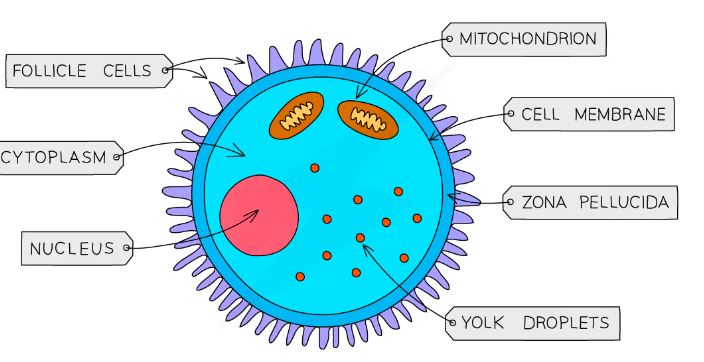
Sperm cell:
Male gamete (responsible for reproduction in males)
→Adaptation
Head contains haploid nucleaus
Acrosome in head contains digestive enzymes to breakdown jelly coat around egg cell so sperm can penetrate egg cell
Many mitochondria to provide energy so sperm can travel long distances
Flagellum allows sperm to travel
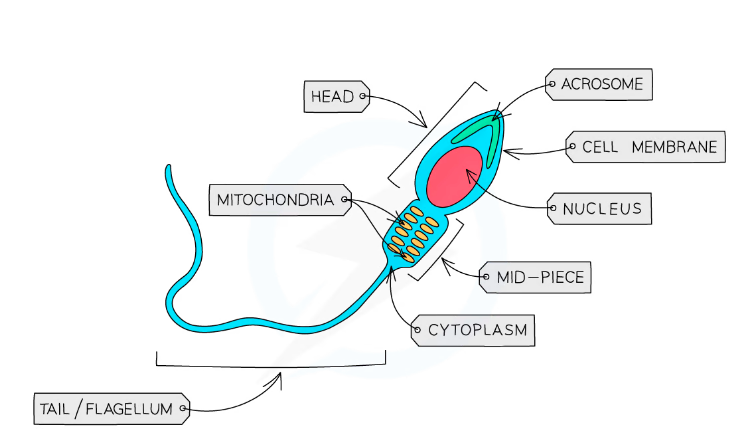
Levels of Organisation
Cell: Basic structural and functional unit of life
Tissue: A group of identical cells which work together to perform a specific function
Organ: Many tissues which work together to perform a specific function
Organism: A group of organ systems which coordinate with each other to create an effective functioning of the body
Cell →Tissue→Organ→Organ System→Organism
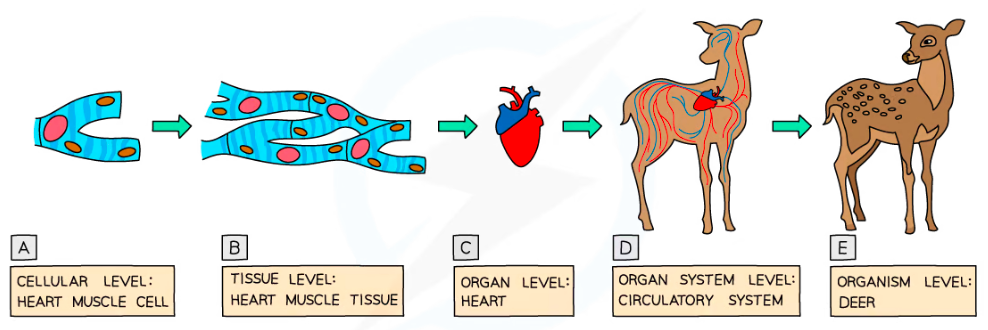
Size of specimens
Size of a structure or an organism
Magnification = Measured lenght / Actual length
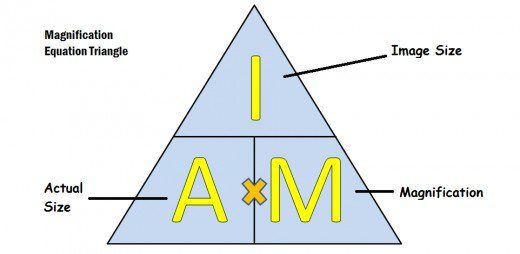
Magnification has no units so is represented as eg. x100
The image size is usually given in centimetres or millimetres so make sure to convert both the actual size and image size units to be the same to get thr correct magnification
1cm = 10mm
1mm = 1000μm (micrometer)
Organisation of the Organism (1.6-1.7)
Cell structure and organisation
All living organisms are made of cells
Cell: The basic structural unit of life
Although cells carry out different functions, animal and plant cells both have common features:
Cell membrane
Cytoplasm
Nucleus
Endoplasmic reticulum
Mitochondria
Ribosomes
Golgi Body
Lysosomes
Plant cell | Animal cell |
|---|---|
Has a cell wall | No Cell wall |
Chloroplasts is present | No chloroplasts |
Vacoules occupy most space | No vacoule |
Starch as carbohydrate store | Glycogen as carbohydrate store |
Autotrophic | Hetrotrophic |
No secretory vesicles | Secretory vesicles present |
Regular shape | Irregular shape |

Functions of Cellular structures
Cell wall: Outer most sstructure in the plant cell, made of cellulose and is dead
→ Fully permeable; allows substances in and out of the cell
→Gives the cell its shape and structure
Cell membrane: Located inner to the cell wall in a plant cell and the outermost structure in an animal cell
→Semi-permeable; allows some/specific substances in and out of the cell
Cytoplasm: Jelly like fluid inside the cell made of water and dissolved substances eg. glucose & salt
→Site of all metabolic (chemical) reactions
Nucleus: Contains genertic material of the cell in chromosomes which controls cell functions
→Controlling centre of the cell
→Determines quality and quantity of proteins made by the cell
Chloroplasts: Site of photosynthesis
→Contains a green pigment (chlorophyl)
→Chlorophyl absorbs light energy and converts it into chemical energy by photosynthesis
6H2O + 6CO2 → C6H12O6 + O6
Mitochondria: Made up of a doublr membrane: inner and outer
→ Inner has many foldings to increase the surface area for enzyme reactions
→Site of aerobic respiration and release energy
→ ‘Powerhouse’ of the cell
Rough of Endoplasmic Reteculum: Membranous outgrowth of outer nuclear membranes and has ribosomes attached to its surface
→Site of synthesis and transport of protein
Ribosome: The smallest cell of organelles present in the cytopplasm
→Either free or attached to rough ER
→Site of protein synthesis
Vacoule: Large, permanent, cenraly located in a plant cell but small and temporary in animal cells. Contain cell sap which is a solution of nutrients and salts
→ Provides turgor pressure to the plant cell and helps maintain its shape
Vesicle: Sac like structures containing secretory substances eg. enzymes in the cytoplasm
Specialised Cells
Large organisms are multicellular
Different types of cells have particular structures to help them carry out specific functions, and so they become specialised
Specialised Cells in Plants
Root hair cells:
Absorb nutrients from soil by osmosis
Absorb minerals by active uptake/transport
Fix the plant in the soil
→Adaptations:
Have finger like outgrowth to increase the surface area for more absorption
Have extended vacoule and cytoplasm for easier absorption
Have more mitochondria to privude energy for active uptake/transport

Xylem vessels:
Found in vascular bundles
Transport water and minerals from the roots to the stem and leaves
Provide mechanical support to the stem and leaves
→Adaptations
Do not have a nucleus or cytoplasm to make space for bulk transport of water and minerals
Cells are dead and hollow and connected from end to end to form a long continous tube
Cell wall is strengthened with lignin (hard substance) which gives mechanical support

Specialised Animal Cells
Red Blood cells:
Transport oxygen from lungs to the rest of the body
Transport CO2 from the body to the lungs
→Adaptation
Red pigment (haemoglobin) which binds with oxygen to allow transport
Dont have a nucleus; increase the surface area to carry more oxygen; biconcave shape
Spongy/ flexible to squeeze into cappilaries

Ciliated Epithelial cells:
Goblet cells secrete mucus which traps the dust particles from the inhaled air
Cillia of the cells beat and push the trapped dust and air towards the throat (outside)

Muscle cell:
Contracts and relaxes and brings about movement
Contracts and relaxes so that structures can be brought closer
→Adaptation
Made of myofibres which have the ability to contract and relax
Have protein fibre; can shorten the cell when energy is present
Nerve cells:
Sensory nerve cell: Conducts message from sense organ to the central nervous system
Motor nerve cell: Carries message from central nervous system to the effector
→Adaptation
Has extensions and branches so that it communicates with other nerve cells and glands
The Axon (extension of the cytoplasm away from cell body to carry impulse long distances) is covered with fatty sheath which insulates the cell and speeds up the nerve impulse

Egg cell:
Female gamete (responsible for reproduction in females)
→Adaptations
Alot of cytoplasm that contains alot of nutrients for the growth of the early embryo
Haploid nucleus containing genetic material for fertilisation
Cell membrane that modifies after fertilisation so that only one sperm cell can penetrate

Sperm cell:
Male gamete (responsible for reproduction in males)
→Adaptation
Head contains haploid nucleaus
Acrosome in head contains digestive enzymes to breakdown jelly coat around egg cell so sperm can penetrate egg cell
Many mitochondria to provide energy so sperm can travel long distances
Flagellum allows sperm to travel

Levels of Organisation
Cell: Basic structural and functional unit of life
Tissue: A group of identical cells which work together to perform a specific function
Organ: Many tissues which work together to perform a specific function
Organism: A group of organ systems which coordinate with each other to create an effective functioning of the body
Cell →Tissue→Organ→Organ System→Organism

Size of specimens
Size of a structure or an organism
Magnification = Measured lenght / Actual length

Magnification has no units so is represented as eg. x100
The image size is usually given in centimetres or millimetres so make sure to convert both the actual size and image size units to be the same to get thr correct magnification
1cm = 10mm
1mm = 1000μm (micrometer)
 Knowt
Knowt
